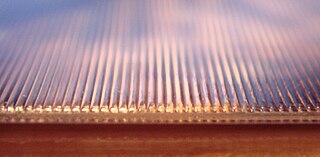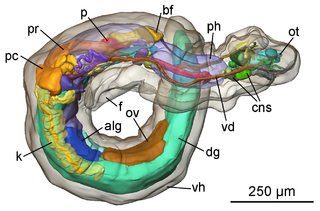
In computer graphics, a raster graphics or bitmap image is a dot matrix data structure that represents a generally rectangular grid of pixels, viewable via a monitor, paper, or other display medium. Raster images are stored in image files with varying formats.

Stereoscopy is a technique for creating or enhancing the illusion of depth in an image by means of stereopsis for binocular vision. The word stereoscopy derives from Greek στερεός (stereos), meaning 'firm, solid', and σκοπέω (skopeō), meaning 'to look, to see'. Any stereoscopic image is called a stereogram. Originally, stereogram referred to a pair of stereo images which could be viewed using a stereoscope.

Depth perception is the visual ability to perceive the world in three dimensions (3D) and the distance of an object. Depth sensation is the corresponding term for animals, since although it is known that animals can sense the distance of an object, it is not known whether they perceive it in the same subjective way that humans do.

Video camera tubes were devices based on the cathode ray tube that were used to capture television images prior to the introduction of charge-coupled device (CCD) image sensors in the 1980s. Several different types of tubes were in use from the early 1930s to the 1980s.
Jerome "Jerry" Hal Lemelson was an American engineer, inventor, and patent holder. Several of his inventions and works in the fields in which he patented have made possible, either wholly or in part, innovations like automated warehouses, industrial robots, cordless telephones, fax machines, videocassette recorders, camcorders, and the magnetic tape drive used in Sony's Walkman tape players. Lemelson's 605 patents made him one of the most prolific inventors in American history.
Patent infringement is the commission of a prohibited act with respect to a patented invention without permission from the patent holder. Permission may typically be granted in the form of a license. The definition of patent infringement may vary by jurisdiction, but it typically includes using or selling the patented invention. In many countries, a use is required to be commercial to constitute patent infringement.

Lenticular printing is a technology in which lenticular lenses are used to produce printed images with an illusion of depth, or the ability to change or move as the image is viewed from different angles.
Cognex Corporation is an American manufacturer of machine vision systems, software and sensors used in automated manufacturing to inspect and identify parts, detect defects, verify product assembly, and guide assembly robots. Cognex is headquartered in Natick, Massachusetts, USA and has offices in more than 20 countries.
A volumetric display device is a graphic display device that forms a visual representation of an object in three physical dimensions, as opposed to the planar image of traditional screens that simulate depth through a number of different visual effects. One definition offered by pioneers in the field is that volumetric displays create 3D imagery via the emission, scattering, or relaying of illumination from well-defined regions in (x,y,z) space.
Stereopsis is a term that is most often used to refer to the perception of depth and 3-dimensional structure obtained on the basis of visual information deriving from two eyes by individuals with normally developed binocular vision. Because the eyes of humans, and many animals, are located at different lateral positions on the head, binocular vision results in two slightly different images projected to the retinas of the eyes. The differences are mainly in the relative horizontal position of objects in the two images. These positional differences are referred to as horizontal disparities or, more generally, binocular disparities. Disparities are processed in the visual cortex of the brain to yield depth perception. While binocular disparities are naturally present when viewing a real 3-dimensional scene with two eyes, they can also be simulated by artificially presenting two different images separately to each eye using a method called stereoscopy. The perception of depth in such cases is also referred to as "stereoscopic depth".

3D scanning is the process of analyzing a real-world object or environment to collect data on its shape and possibly its appearance. The collected data can then be used to construct digital 3D models.

Autostereoscopy is any method of displaying stereoscopic images without the use of special headgear or glasses on the part of the viewer. Because headgear is not required, it is also called "glasses-free 3D" or "glassesless 3D". There are two broad approaches currently used to accommodate motion parallax and wider viewing angles: eye-tracking, and multiple views so that the display does not need to sense where the viewers' eyes are located. Examples of autostereoscopic displays technology include lenticular lens, parallax barrier, volumetric display, holographic and light field displays.
Monocular vision is vision in which both eyes are used separately. By using the eyes in this way the field of view is increased, while depth perception is limited. The eyes of an horse with monocular vision are usually positioned on opposite sides of the animal's head, giving it the ability to see two objects at once. The word monocular comes from the Greek root, mono for single, and the Latin root, oculus for eye.

Microtek International Inc. is a Taiwan-based multinational manufacturer of digital imaging products and other consumer electronics. It produces imaging equipment for medical, biological and industrial fields, occupies 20% of the global imaging market and holds 450 patents worldwide.

Scanography, more commonly referred to as scanner photography, is the process of capturing digitized images of objects for the purpose of creating printable art using a flatbed "photo" scanner with a CCD array capturing device. Fine art scanography differs from traditional document scanning by using atypical objects, often three-dimensional, as well as from photography, due to the nature of the scanner's operation.
Parallax scanning depth enhancing imaging methods rely on discrete parallax differences between depth planes in a scene. The differences are caused by a parallax scan. When properly balanced (tuned) and displayed, the discrete parallax differences are perceived by the brain as depth.

In computer vision and computer graphics, 3D reconstruction is the process of capturing the shape and appearance of real objects. This process can be accomplished either by active or passive methods. If the model is allowed to change its shape in time, this is referred to as non-rigid or spatio-temporal reconstruction.
Ran Poliakine is an Israeli businessman, the founder and former CEO of Powermat Technologies. Poliakine is a serial entrepreneur, inventor and industrial designer, who uses advanced technology in order to create social impact. Over the last 25 years, Poliakine has directed his efforts and funds towards modernizing gynecology, eradicating cancer, and freeing workers from meaningless employment.

Subhasis Chaudhuri is an Indian electrical engineer and director at IIT Bombay. He is a former K. N. Bajaj Chair Professor at the Department of Electrical Engineering of the Indian Institute of Technology, Bombay. He is known for his pioneering studies on Computer vision and is an elected fellow of all the three major Indian science academies viz. the National Academy of Sciences, India, Indian Academy of Sciences, and Indian National Science Academy. He is also a fellow of Institute of Electrical and Electronics Engineers, and the Indian National Academy of Engineering. The Council of Scientific and Industrial Research, the apex agency of the Government of India for scientific research, awarded him the Shanti Swarup Bhatnagar Prize for Science and Technology, one of the highest Indian science awards for his contributions to Engineering Sciences in 2004.
MicroVision, Inc. is a US company that develops laser scanning technology for projection, augmented reality, 3D sensing, and image capture. MicroVision's display technology uses a micro-electrical mechanical systems (MEMS) scanning mirror with red, green, blue, and infrared lasers, optics and electronics to project and/or capture images. The company licenses its products primarily to original equipment manufacturers (OEMs) such as Microsoft, Apple, the US Military, and STMicroelectronics.










